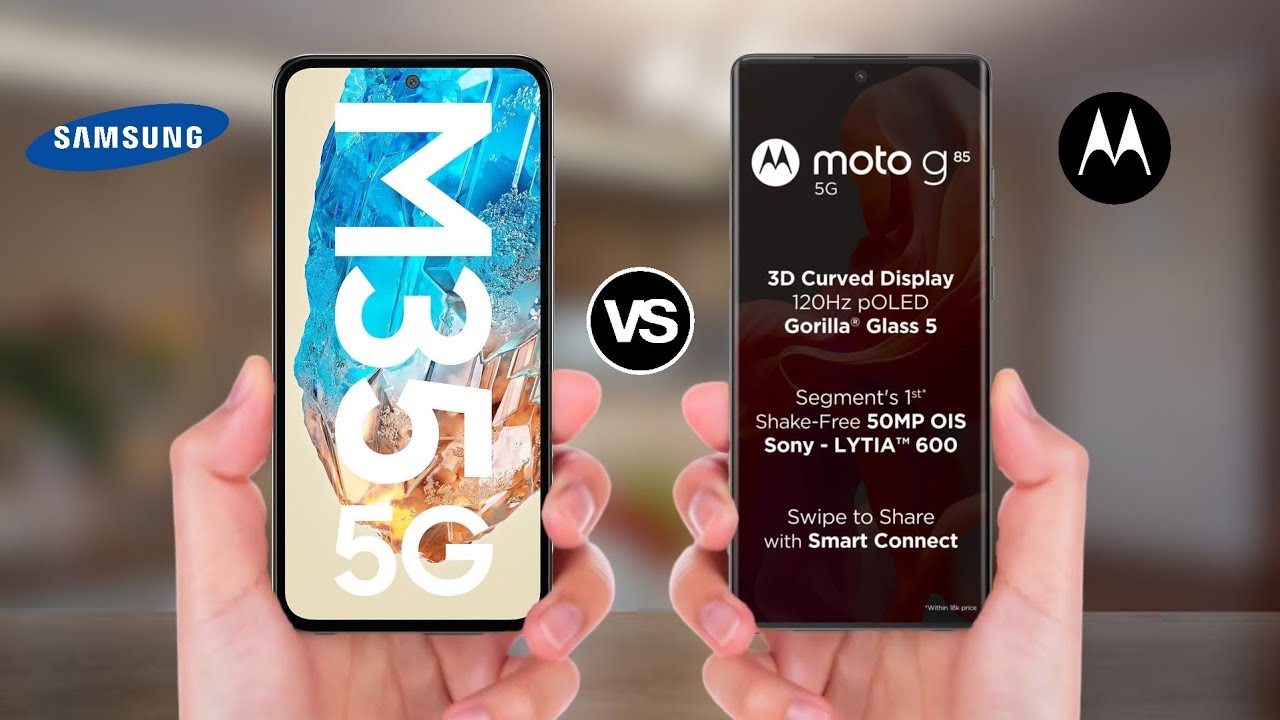The mid-range smartphone market is heating up, with fierce competition between brands like Samsung and Motorola. Two notable contenders in this arena are the Samsung Galaxy M35 5G and the Motorola G85 5G. Both devices offer compelling features and attractive price points, but which one truly delivers the best value for money? Let’s dive into a detailed comparison to help you make an informed decision.

Design and Display: A Battle of Aesthetics and Functionality
The Samsung Galaxy M35 5G adopts a familiar design language, with a punch-hole cutout for the selfie camera and relatively thick bezels. While not the most stylish option, the device compensates with a vibrant 6.6-inch Super AMOLED display that boasts FHD+ resolution, a 120Hz refresh rate, and impressive peak brightness. Samsung has also fortified the display with Corning Gorilla Glass Victus+ for enhanced durability. However, the M35 5G comes with a trade-off: it’s a bit bulkier than its rival.
The Motorola G85 5G, on the other hand, prioritizes a sleek and lightweight design. Its vegan leather back panel exudes a premium feel, and the slim profile makes it comfortable to hold. The 6.7-inch FHD+ P-OLED display is equally impressive, offering vibrant colors, deep blacks, and a smooth 120Hz refresh rate. Motorola also takes the lead in terms of peak brightness, delivering a more immersive viewing experience under bright sunlight.
Performance: Powering Through Tasks
When it comes to performance, both the Samsung Galaxy M35 5G and the Motorola G85 5G deliver solid results for everyday tasks and light gaming. The M35 5G relies on Samsung’s in-house Exynos 1380 chipset, while the G85 5G is powered by Qualcomm’s Snapdragon 6s Gen 3. While both processors are capable, the M35 5G benefits from a vapor cooling chamber, which helps maintain optimal performance during demanding tasks.
Camera Showdown: Capturing Your Moments
Photography enthusiasts will find capable camera systems on both devices. The Samsung Galaxy M35 5G sports a triple-camera setup, including a 50MP primary sensor with optical image stabilization (OIS) for steady shots. The Motorola G85 5G counters with a dual-camera system featuring a 50MP main sensor, also equipped with OIS. Both phones offer good overall camera performance, with the ability to capture decent photos in various lighting conditions.
Battery Life and Software: Endurance and Experience
Battery life is crucial for modern smartphone users, and both devices deliver impressive results. The Samsung Galaxy M35 5G boasts a massive 6,000mAh battery, ensuring extended usage without frequent charging. The Motorola G85 5G, while equipped with a slightly smaller 5,000mAh battery, still offers ample battery life for most users.
In terms of software, the Galaxy M35 5G runs Samsung’s One UI 6.1 based on Android 14, offering a feature-rich interface and a long-term software support commitment. The Motorola G85 5G opts for a near-stock Android 14 experience, prioritizing simplicity and clean design.
Price and Final Verdict
The Samsung Galaxy M35 5G starts at Rs. 19,999, while the Motorola G85 5G is slightly more affordable at Rs. 17,999. The choice between the two ultimately depends on your priorities.
If you prioritize a large battery, a vibrant display, and a feature-packed user interface, the Samsung Galaxy M35 5G is a solid choice. However, if you prefer a sleeker design, a near-stock Android experience, and a slightly more affordable price tag, the Motorola G85 5G might be the better option.
FAQs
Which phone has a better display?
Both phones offer impressive displays, but the Motorola G85 5G has a slight edge in terms of peak brightness.
Which phone offers better battery life?
The Samsung Galaxy M35 5G generally offers longer battery life due to its larger battery capacity.
Which phone has a cleaner software experience?
The Motorola G85 5G provides a near-stock Android experience, while the Samsung Galaxy M35 5G offers a more customized interface.
Which phone is better for gaming?
The Samsung Galaxy M35 5G might have a slight advantage due to its vapor cooling chamber, which can help with sustained performance.




